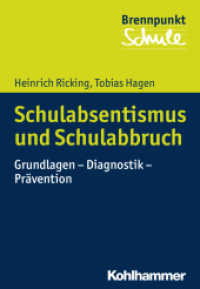- ホーム
- > 洋書
- > 英文書
- > Computer / General
Full Description
Cardiovascular and Coronary Artery Imaging, Volume Two presents the basics of echocardiography, nuclear imaging and magnetic resonance imaging (MRI) and provides insights into their appropriate use. The book covers state-of-the-art approaches for automated non-invasive systems for early cardiovascular and coronary artery disease diagnosis. It includes several prominent imaging modalities such as MRI, CT and PET technologies. Other sections focus on major trends and challenges in this area and present the latest techniques for cardiovascular and coronary image analysis.
Contents
Part A: Cardiovascular Imaging
Section 1: Cardiovascular Perfusion Imaging
1. Relation of pulse pressure and arterial stiffness to concentric left ventricular hypertrophy in young men left ventricular perfusion and function by gated SPECT myocardial perfusion imaging
2. Metabolic Mechanisms in Heart Failure
3. Myocardial Scarring on Outcomes of Cardiac Resynchronization
4. Cardiac resynchronization therapy
Section 2: Other Imaging Modalities
5. Arterial ultrasonography and tonometry as adjuncts to cardiovascular risk stratification
6. Comparison of arterial functional evaluations as a predictor of cardiovascular events
7. Predicting cardiac events using ventricular dyssynchrony
8. The blood pressure response to vasodilator stress
Part B: Coronary Imaging
Section 1: Myocardial Perfusion Imaging
9. Cardiac Magnetic Resonance Assessment of Dyssynchrony
10. Importance of Nonobstructive Coronary Artery Disease in the Prognosis of Patients with Heart Failure
11. Survival and Heart Failure Hospitalization in Patients with Cardiac Resynchronization Therapy
Section 2: Other Imaging Modalities
12. Comparative effectiveness of coronary CT angiography vs stress cardiac imaging
13. Myocardial ischemia in the absence of obstructive coronary lesion
14. Diagnosis of Coronary heart disease
15. Computed Tomography Angiography of Coronary heart disease
16. Outcomes of non-invasive diagnostic modalities for the detection of coronary artery disease








